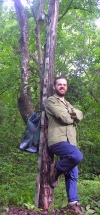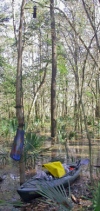               |
 Audio Recordings |
||||||
| Kents and double
knocks At present, our best tangible evidence for the presence of Ivory-billed Woodpeckers along the Choctawhatchee River is recordings of double knocks and kent calls. Instead of drumming like all other woodpeckers that breed in the Southeastern U.S. Ivory-billed Woodpeckers rap on trees with their bills twice in quick succession. These sounds are called double knocks and the ivorybill is the only bird in North America that gives such displays. Our recordings are available for listening on Dan Mennill's Ivory-billed Woodpecker Webpage. The vocalization of Ivory-billed Woodpeckers is a brief nasally sound that is most often written as “kent”. These kent vocalizations are very distinct from the sounds of any other woodpecker in the Southeastern U.S. and distinct from the sounds of most other animals of southern swamps. Blue Jays and both White-breasted and Red-breasted Nuthatches can make ivorybill-like sounds, as can Gray Squirrels. Between January 5 and April 23, 2006, Dan and Kyle made 11,419 hours of audio recordings with seven listening stations. These stations were spaced about 500 meters apart across our study site. As of August 13, 2006 , Dan’s crew has searched all 11,419 hours for double knocks and kent calls and they’ve found 99 putative double knocks and 210 putative kent calls. These are the number of double knocks and kent calls that Dan, Kyle, Brian, Tyler, and Geoff think cannot be attributed to any known animal in the Choctawhatchee River Basin and that sound most like the descriptions or recordings of Ivory-billed Woodpecker vocalizations and knocks. The microphones used to record these sounds are omnidirectional—record sounds from all directions—which is necessary when recording sounds from a source that can be anywhere around a microphone, but our use of omnidirectional mics means that many of the recordings are faint. These sounds cannot be readily attributed to any animal of the Florida panhandle except Ivory-billed Woodpeckers. See Dan Mennill's Ivory-billed Woodpecker Webpage for a detailed treatment of sounds and to listen to all of the putative ivorybill sounds that we have recorded. Perhaps the most compelling aspect of our sound recordings is that on ten days we recorded multiple kent calls and double knocks at the same listening station or at adjacent listening stations separated by 500 meters. One could perhaps dismiss our recorded kent calls as atypical vocalizations of Blue Jays although Blue Jays were absent from all but the edge of our study site throughout the winter and members of our search team have yet to hear Blue Jays make sounds like our putative kent calls. Moreover, typical Blue Jay sounds are never recorded in association with these kent calls. Because jays are vocal birds, it is unlikely that our kent recordings can be attributed to Blue Jays silently approaching a microphone, giving one or a few kent notes, and then slipping silently away. Likewise, double knocks could be atypical drum patterns of Pileated Woodpeckers, but such pileated double knocks must be rare because there is no mention of such pileated double knocks in the literature, and no members of our search team have heard pileateds make such double knocks along the Choctawhatchee or anywhere else in the southern forests. What are the chances that rare Blue Jay kent calls and rare pileated double knocks would occur together in the same spot on ten separate days of recording? It seems to us that a knocking and vocalizing Ivory-billed Woodpecker as the source of the kents and double knocks is the simpler explanation, especially when the location of the sound recording is where 13 sightings were made and there are many scaled trees and large cavities. |
  |
||||||
| All information on this
website is
copyright Geoffrey Hill and Daniel Mennill. No information on this page may used without explicit permission (ghillATacesagDOTauburnDOTedu or dmennillATuwindsorDOTca). |
|||||||
 |
 |
 |
 |
 |
 |
 |
 |